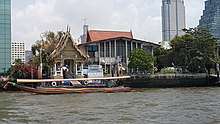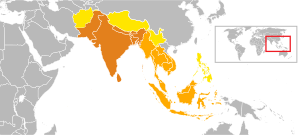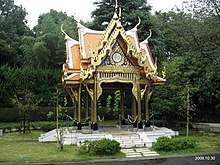Sala (Thai architecture)
A sala (Sanskrit: śāla (IAST: śālā), Thai: ศาลา Thai pronunciation: [sǎːlaː]; Khmer: សាលា Khmer pronunciation: [saːliːə]), also known as a Sala Thai, is an open pavilion, used as a meeting place and to give people shade. With etymological roots in the Sanskrit sala, the word in Thai connotes buildings for specific purposes, such as sala klang ('provincial hall').[1] Most are open on all four sides. They are found throughout Thailand in Buddhist temple areas, or wats, although they can also be at other places. A person who builds a sala at a temple or in a public place gains religious merit. A sala located in a temple is called a salawat (ศาลาวัด). Some temples have large salas where laity can hear sermons or receive religious instruction. These are called sala kan parian (ศาลาการเปรียญ), meaning 'pavilion where monks learn for the Parian examination'. The city halls or offices of the province governors are called sala wa kan (ศาลาว่าการ, literally meaning 'government pavilion') or sala klang changwat (ศาลากลางจังหวัด, literally meaning a 'provincial main pavilion').

In Thailand, they have many purposes similar to the roadside pavilions of Asoka. In rural areas, travelers can use them to rest and reflect. These salas are called sala asai. One at the roadside is a sala rim thanon (ศาลาริมถนน) and may be used as a bus stop. If on a riverbank or canal at a landing-place for watercraft, they are called sala tha nam (ศาลาท่าน้ำ 'water pier pavilions').
Etymology

The term "sala" earliest known mention is found in Atharvaveda,[2] which is an Indian Hindu text written in sanskrit language,[2] which has been dated to 1200 BC to 1000 BC.[3][4] "Sala" in Atharvaveda and later in various Indian languages denotes "house" in a broad and generic sense, with meanings such as "stall" for cattle, "shed" for corn, room or house, etc. The owner or the head of the house is called the "sala-pati" in Atharvaveda.[2] Term "sala" is a cognate of Hindi शाल, meaning hall, large room or shed.[5]
With expansion of Indosphere cultural influence of Greater India,[6] through transmission of Hinduism in Southeast Asia[7][8][9] and the Silk Road transmission of Buddhism[10][11] leading to Indianization of Southeast Asia through formation of non-Indian southeast Asian native Indianized kingdoms[12] which adopted sanskritized language[13] and other Indian elements[14] such as the honorific titles, naming of people, naming of places, mottos of organisations and educational institutes as well as adoption of Indian architecture, martial arts, Indian music and dance, traditional Indian clothing, and Indian cuisine, a process which as been also aided by the ongoing historic expansion of Indian diaspora.[15] During the pre-islamic and pre-colonial phase, through the Indianised Hindu-Buddhist kingdoms of southeast asia the usage of term "sala" and other sanskrit words of Indian origins then spread to various other nations within Indospehere including Thailand, Philippines, Indonesia, Singapore, Brunei, Cambodia, etc.
Salas outside Thailand
- Olbrich Botanical Gardens, Madison, Wisconsin, United States
- East–West Center, Honolulu, Hawaii, United States
- Ueno Zoological Gardens, Tokyo, Japan
- Parc du Denantou, Lausanne, Switzerland
See also
References
- Hiranthanawiwat, Suphawat (2013-09-27). "The 'sala': architectural embodiment of Thai identity". The Nation. Retrieved 31 January 2018.
- "vedic Index of names and subjects, Vol II". 1912. p. 376. Retrieved 2020-01-01.
- Michael Witzel (2003), "Vedas and Upaniṣads", in The Blackwell Companion to Hinduism (Editor: Gavin Flood), Blackwell, ISBN 0-631215352, page 68
- Michael Witzel. "Autochthonous Aryans?The Evidence from Old Indian and Iranian Texts" (PDF).
- "sala". Spoken Sanskrit Dictionary. Retrieved 2012-06-11.
- Kenneth R. Hal (1985). Maritime Trade and State Development in Early Southeast Asia. University of Hawaii Press. p. 63. ISBN 978-0-8248-0843-3.
- Guy, John (2014). Lost Kingdoms: Hindu-Buddhist Sculpture of Early Southeast Asia, Metropolitan museum, New York: exhibition catalogues. Metropolitan Museum of Art. ISBN 9781588395245.
- "The spread of Hinduism in Southeast Asia and the Pacific". Britannica.
- Kapur; Kamlesh (2010). History Of Ancient India (portraits Of A Nation), 1/e. Sterling Publishers Pvt. Ltd. p. 465. ISBN 978-81-207-4910-8.
- Fussman, Gérard (2008–2009). "History of India and Greater India". La Lettre du Collège de France (4): 24–25. doi:10.4000/lettre-cdf.756. Retrieved 20 December 2016.
- Coedès, George (1968). Walter F. Vella (ed.). The Indianized States of Southeast Asia. trans.Susan Brown Cowing. University of Hawaii Press. ISBN 978-0-8248-0368-1.
- Manguin, Pierre-Yves (2002), "From Funan to Sriwijaya: Cultural continuities and discontinuities in the Early Historical maritime states of Southeast Asia", 25 tahun kerjasama Pusat Penelitian Arkeologi dan Ecole française d'Extrême-Orient, Jakarta: Pusat Penelitian Arkeologi / EFEO, pp. 59–82
- Lavy, Paul (2003), "As in Heaven, So on Earth: The Politics of Visnu Siva and Harihara Images in Preangkorian Khmer Civilisation", Journal of Southeast Asian Studies, 34 (1): 21–39, doi:10.1017/S002246340300002X, retrieved 23 December 2015
- Kulke, Hermann (2004). A history of India. Rothermund, Dietmar 1933- (4th ed.). New York: Routledge. ISBN 0203391268. OCLC 57054139.
- Kulke, Hermann (2004). A history of India. Rothermund, Dietmar, 1933– (4th ed.). New York: Routledge. ISBN 0203391268. OCLC 57054139.
External links
| Wikimedia Commons has media related to Sala (architecture). |
- Elements and parts of Thai architecture
- East-West Center, A Commemorative Book by the Thai Students at the East-West Center on the Occasion of the Presentation of the Asia Pacific Community Building Award and Dedication of the Royal Sala Thai, Honolulu, East-west Center, 2008.
